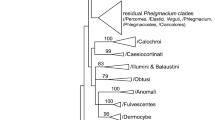Abstract
Two new species of Camillea are described from localities on an east–west transect through Ecuador between the latitudes 1°00’N and 1°00’S. Camillea ovalispora was collected in San Vicente de Huaticocha, an area characterized as humid lowland rainforest and premontane cloud forest; C. unistoma was collected at Cuyabeno, a protected area with black water inundated forest and primary rainforest on terra firme. Further, C. heterostoma var. macrospora is elevated to full species status as C. macrospora. New country records of six Camillea species are annotated from the same east-west transect. These are C. flosculosa, C. fossulata, C. hainesii, C. macrospora, C. scriblita, and C. tinctor. Also, previously recorded species have been annotated with new specimens added. Additionally, six distinct taxa from the transect that appear to be undescribed were included in the analysis; one is partly described but not the others due to insufficient material. The data showed an obvious altitude influence on the distribution and frequency of Camillea species. The diversity of species is lower on the western part of the transect compared to the eastern side, probably due to multiple factors such as differences in search intensity between the two slopes, difference in annual rainfall, and possibly the availability of host plants. Camillea taxa were only found at altitudes below 2,000 m, with the highest diversity below 600 m. Palmae is reported as a new host for Camillea species.


Similar content being viewed by others
References
Balslev H, Luteyn J, Øllgaard B, Holm-Nielsen LB (1987) Composition and structure of adjacent unflooded and floodplain forest in Amazonian Ecuador. Opera Bot 92:37–57
Best BJ, Heijnen T, Williams R (eds) (1996) A guide to bird-watching in Ecuador and the Galápagos Islands. Biosphere Publications, West Yorkshire, UK
Fries E (1849) Summa Vegetabilium Scandinaviae, Part 2. Stockholm and Leipzig.
Gentry AH (1982) Phytogeographic patterns as evidence for a Chocó refuge. In: Prance GT (ed) Biological diversification in the tropics. Columbia University Press, New York, pp 112–136
Herrera-MacBryde O, Neill DA (2008) Yasuni National Park and Waorani ethnic reserve. http://www.nmnh.si.edu/botany/projects/cpd/sa/sa8.htm
Kornerup A, Wanscher JH (1974) Farver i Farver, 5 oplag. Politikens, København
Lodge DJ, Læssøe T (1995) Host preference in Camillea verruculospora. Mycologist 9(4):152–153. doi:10.1016/S0269-915X(09)80004-9
Læssøe T, Petersen JH (2007). EcuaColl database, http://www.mycokey.com/Ecuador.html
Læssøe T, Rogers JD, Whalley AS (1989) Camillea, Jongiella and light-spored species of Hypoxylon. Mycol Res 93:121–155. doi:10.1016/S0953-7562(89)80111-X
Minter DW, Rodríquez Hernández M, Mena Portales J (eds) (2001) Fungi of the Caribbean. An annotated checklist. PDMS Publishing, Isleworth, UK
Neill DA, Jørgensen PM (1999) http://www.mobot.org/MOBOT/research/ecuador/climates.shtml
Okane I, Nakagiri A (2007) Taxonomy of an anamorphic xylariaceous fungus from a termite nest found together with Xylaria angulosa. Mycoscience 48:240–249. doi:10.1007/s10267-007-0361-9
Petrak F (1950) Beiträge zur Pilzflora von Ekuador. Sydowia 4:450–587
Rogers JD, Læssøe T, Lodge DJ (1991) Camillea: New combinations and a new species. Mycologia 83:224–227. doi:10.2307/3759939
Rogers JD, San Martín Gonzales F, Ju Y-M (2002) Three new taxa of Camillea from Costa Rica. Sydowia 54:84–90
San Martín González F, Rogers JD (1993) Biscogniauxia and Camillea in Mexico. Mycotaxon 47:229–258
Sánchez-Ballesteros J, González V, Slazar O, Acero J, Portal MA, Julián M, Rubio V, Bills GF, Polishook JD, Platas G, Mochales S, Peláez F (2000) Phylogenetic study of Hypoxylon and related genera based on ribosomal ITS sequences. Mycologia 92:964–977. doi:10.2307/3761591
Whalley MA (1995) Camillea fusiformis sp. nov. from Ecuador. Sydowia 47:82–88
Whalley MA (1996) Distinctive features of Camillea (Xylariaceae) from Cuyabeno as revealed by scanning electron microscopy. Mycologist 10:149–151. doi:10.1016/S0269-915X(96)80003-6
Whalley MA, Whalley AJS, Gareth Jones EB (1996) Camillea selangorensis sp. nov. from Malaysia. Sydowia 48:145–151
Whalley MA, Whalley AJS, Thienhirun S, Sihanonth P (1999) Camillea malaysianensis sp. nov. and the distribution of Camillea in Southeast Asia. Kew Bull 54:715–722. doi:10.2307/4110867
Acknowledgements
We would like to thank Lisbeth Haukrogh for assistance with SEM, Jørgen Kristiansen for help with the Latin diagnoses, Javier Salazar, Peter Møller Jørgensen and Jens H. Petersen for field work assistance, and, likewise, Anne-Marie Connolly-Andersen, who also gave valuable help with data handling, and Pontifica Universidad Católica del Ecuador, Quito for providing facilities while working with the specimens. Grants to support the project were kindly given by RUF (no. 91056), “Ingeniør Svend G. Fiedler og hustrus legat til fremme af botanisk og arkæologisk forskning” and ”Dansk Botanisk forening”. Royal Botanic Gardens, Kew supported field work in 1993 and Aarhus University in 1983. All involved in the British Mycological Society rainforest expedition to Cuabeno and in the Danish–Ecuadorian–Norwegian expedition to the Yasuni Field station are thanked for support.
Author information
Authors and Affiliations
Corresponding author
Additional information
Misc
Taxonomical novelties: Camillea macrospora (J.H. Miller) Hastrup & Læssøe; Camillea ovalispora Hastrup & Læssøe; Camillea unistoma Hastrup & Læssøe
Rights and permissions
About this article
Cite this article
Hastrup, A.C.S., Læssøe, T. Camillea (Xylariaceae, Ascomycota), including two new species, along a trans-Andean altitude gradient in Ecuador. Mycol Progress 8, 305–316 (2009). https://doi.org/10.1007/s11557-009-0601-9
Received:
Revised:
Accepted:
Published:
Issue Date:
DOI: https://doi.org/10.1007/s11557-009-0601-9




